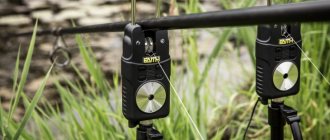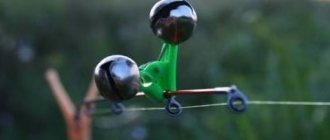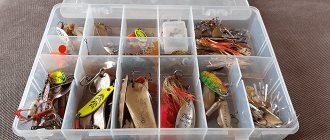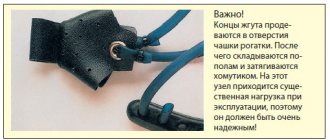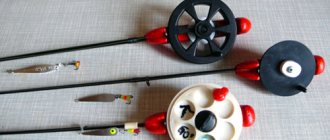The task of a fishing alarm is to provide a clear reaction, understandable to the fisherman, to a fish biting or touching the bait and hook. Such indicators may have visual, audio or audible alarms. The use of alarms provides the fisherman with the following opportunities:
- When using this device, there is no need to constantly be on guard and literally guard the gear.
- Its use makes fishing more comfortable.
- If you need to monitor several tackles at the same time, the alarm will allow you not to miss a bite.
- With a large number of gears, you can set up different sound signals so that it is clear which way to run - which ringing.
- If there are indicators, the fisherman will not miss the right moment and will make the hook on time.
Bells are an old-fashioned method of indicating a bite.
If you do not respond to a bite in time, the fish will fall off the hook and be lost. The alarm will make fishing calmer, more measured and effective. This is especially important if fishing is combined with outdoor recreation.
Perhaps the simplest bite alarm is a split stick with a fishing line attached to the slot. When bitten, the block flies up, or, on the contrary, falls down, depending on whether the fish is coming towards you or from the fisherman. A more advanced option, bells/bells, are alarms that are still used by modern bottom fishers, feeders and floaters to register bites.
Bells are a cheap and effective bite indicator, but are a pain in the wind
Types of bite alarms, what are the requirements for indicators for fishing
Alarms make a sound, emit light or physically move during a bite, therefore indicators are divided into electronic (sound and light), simply sound (bells, bells, rattles), simply glowing (various fireflies) and mechanical (visual impact). There are also combined options. Mechanical indicators, in turn, are divided into swingers, hangers, climbing monkeys, and springers.
Swinger
Hanger
Springers for fishing
In order to effectively perform their task, alarms must provide the following functions:
- Stand out clearly against the background of the surrounding environment (for example, on the water or in thickets).
- The device should not prevent the fisherman from changing the line tension as needed.
- The alarm must remain stable in the event of gusts of wind or the formation of waves.
- The indicator should be conveniently installed on the stand.
- When biting, it should not grab the thread or interfere with the landing of the fish.
- It is convenient when there is an LED inside. This helps to better control the gear and improves visibility of the device in low light conditions.
The most important characteristics are the sensitivity and visibility of the supplied signal.
Shape of gum bite alarm
The photo shows pendulum bite alarms of round and triangular shapes, each of which can be easily made with your own hands using simple methods for fishing elastic.
Although the shape of the lead blank, due to its relatively small size, does not play a special role, the streamlined pendulum bite alarm installed on the supporting fishing line of the fishing elastic is less susceptible to gusts of wind.
Therefore, you can make a bite alarm from lead for a triangular, diamond-shaped, conical or olive-shaped bottom that can be thrown by hand. I use the same shapes of signal sinkers to visually record fish bites on fishing elastic hooks.
To reduce the sensitivity of the gear to gusts of wind on casting bottoms, I replace the bulky lead bite alarms with flat alarm springs, which I made with my own hands about 45 years ago, but I rarely use them on fishing trips.
Spring bite alarms are not suitable for fishing with a rubber band due to the high installation location. But when fishing in windy weather with several donks thrown from the hand, the flat, low-volume shape of the spring is practically not affected by the wind.
I prefer to protect the bite alarms of fishing rubber bands from swaying by waves and wind with other means, made with my own hands right on the shore in a few minutes. This material is covered on the next topic page.
How to make a round gum bite alarm
The round rod of my pendulum bite alarm is hand-carved from dry pine, to which a round lead blank of the same diameter is glued below the red line.
A twisted ring of tinned steel wire 1-1.5 mm thick is glued into the top of the signaling device.
The length of the round part of the pendulum fish bite alarm - 60-70 mm is not critical and yours may be different. Read below to learn how to make a round-shaped weight for a pendulum signaling device with your own hands.
Electronic bite alarm: choosing the best model
Using electronic devices as bite alarms has its advantages:
- In these devices, you can independently adjust the sensitivity.
- Electronic alarms are capable of producing several types of signals.
- Convenient and reliable fastenings are provided for fixing to the rod.
- Ease of setup and use of modern electrical alarms.
- It is possible to connect to other types of electronic devices - mobile devices, tablets.
Such a signaling device is attached to the fishing rod so that it presses the line and can sense even the slightest movement of the line. When a bite is detected, it gives a sound or light signal. The ability to set your own parameters will help, for example, in cases where the bite of a carp needs to be distinguished from a simple movement of the feeder along the bottom of a reservoir in the current.
Hoxwell Indicator Set with Pager - Model HL54
An electronic bite alarm with pager provides additional bite notification capabilities. Typically, the fisherman must be in close proximity to receive the signal. This design additionally uses a transmitter capable of transmitting a signal over a distance of up to one hundred meters.
With this device, when fishing at night, there is no need to constantly check your gear. Just put the transmitter in your pocket and wait for the signal.
Mikado AMS01-HS-D
This model is designed for those anglers who fish with live bait. It provides fine-tuning of sensitivity, which will allow you to filter the bite signal from random movements of the bait.
To increase the reliability of fastening when catching large fish, belts are used. As a disadvantage, it is noted that it is impossible to adjust the level of the bite signal.
LED bite alarm Megatex Soyka-4
This model has high sensitivity. She can easily distinguish a bite from other types of line twitching. The bite signal is given by flashing the LED or using a sound signal. The weight of the device does not exceed 50 grams.
TONGUU fishing alarm with indicator light
Here the manufacturer paid special attention not only to the quality of the alarm, but also to the strength of the connection with the spinning rod. For this purpose, a strong clamp with an eccentric is used. A sound or light signal can be used for notification. Its intensity can be adjusted. The disadvantage is the lack of bite force adjustment.
Mikado AMS01-HX bite alarm with different indicators
This model provides fine-tuning of the sensitivity of the device. To provide a signal, two LED indicators of different colors are used, located on the sides of the device. Green corresponds to the beginning of a bite, and red to strong jerks. If desired, the fisherman can set a color alert.
Barracuda T5 (Condor Barracuda T5) with various types of alarms - sound, light
The product was created by Chinese. The device is made in the form of the top of a fishing rod stand. Here you can insist on determining the speed of movement of the fishing line, the volume and tone of the bite signal. You can also use light signaling in the form of a blinking LED.
EASTSHARK SP-01
The product line of this company includes many high-quality models, but SP-01 is considered the most popular. Here, 8 volume levels and 8 types of tonality are provided for signaling. The alarm can use 5 sensitivity levels in its operation.
Annunciator
This bite alarm device combines ease of use and high efficiency. It is attached to the rod using a clip. The device provides light and sound bite indication. The action of the alarm is based on determining the degree of tension of the fishing line.
Delkim - electronic alarm with pager
Notification via pager is provided. This can be done using a sound signal or vibration. Up to six alarms can be connected to one central device at the same time.
Kosadaka T4
In this indicator you can adjust the volume and tone of the alert. The device allows you to adjust the sensitivity level. The alarm is well protected from moisture and the possibility of mechanical damage.
Mechanical bite alarms
Bite indicators with mechanical alerts detect bites for the angler based on changes in the movement of the rod and line. These devices are less functional compared to electronic ones. But more reliable.
Winter signaling device "Crane" Megatex
The Crane bite detector is available in electronic and mechanical types, the latter includes a coupling attached to the rod and two arms. A fishing line passes through one, and a weight is attached to the other. Both sides must be in balance. When jerking, it is broken and is a signal for the fisherman to make a hook.
Prologic K3 Hang Indicator Set 3 Rod
In this hanger model, a small colored bulb has attachments to the fishing line and a thread on which it is suspended from the rod. When a fish pulls the alarm, the movement of the color cone attracts the fisherman's attention.
Mikado AMR02-1199-22
Two bells are attached to a plastic clothespin. It is attached to the fishing rod. When moving, the bells collide with each other and begin to ring. The simplicity and reliability of the device are guaranteed by the well-known src=”https://tytkleva.net/wp-content/uploads/2021/03/Mikado-AMR02.jpg” class=”aligncenter” width=”1000″ height=”633″[/ img]
Swingers Hoxwell
It is a spring in a plastic tube. The fishing line along the fishing rod is passed through both rings attached to the edges. On one side there is a luminous element and a weight. When biting, you can see the movement of the alarm.
Mikado Swinger AIX-8490
Before use, the alarm is attached in such a way that it deflects the fishing line from a vertical position. As soon as the fish bites, the line will straighten and the device will take a position parallel to the line.
Swinger Kosadaka FL-1139
The device deflects the line in the standby state. After the fish grabs the bait, a bright-colored signal cylinder moves upward, signaling the fisherman to strike.
Nash Bobbin Kit
The design consists of a bright acrylic body, a small chain (8 cm) and a fastener. There is a double line clamp: one is released after a sharp jerk of the fish, the other lasts longer. As soon as a bite occurs, there is a sharp movement of the acrylic cylinder.
Matrix Innovations Aero-Hangers
The indicator ring is attached to the rod. A bright cylinder, which is suspended on a cord, is attached to the fishing line using clamps. As soon as the fish grabs the hook, the fisherman will immediately notice its movement. This model is characterized by a high level of sensitivity.
SALMO cluster bells - simple and effective fishing alarms
They are bells that will sound a sound signal when the fishing line moves. They hang on springs on both sides of the rod. When there is a shock, the fisherman will know that a bite has occurred.
Bell Sleeve SWD
It is distinguished by its simplicity of design and low cost. It is a bell in a cylindrical body. It is attached to the rod using a clamp. When a shock occurs, a sound signal sounds.
DIY bite alarm
The most common homemade donkey gatehouses are:
- pendulum type;
- nod type.
A homemade universal signaling device for donkey is mounted on a fishing line and attached to the rod rings. When a fish bites, the tackle, which is in a tense state, changes its position in the water, and the fishing line moves, transmitting vibrations to the guard.
The advantage of such a signaling device is that it is attached to the rod and remains hanging on its ring when hooking. However, the fisherman needs to monitor the bottom tackle with a hand-made pendulum sensor for the bottom in order to make a hook in time.
The easiest way
To make the simplest pendulum tracking sensor for a donkey you will need:
- a piece of aluminum or copper wire 20−25 cm long;
- 2 cambrics with a diameter slightly larger than the diameter of the wire section;
- lead weight with a ring;
- pliers.
The procedure for making a homemade tracking sensor for a donkey:
- put the weight on the wire and fix it in the middle by twisting the wire into a ring;
- put cambrics on the wire;
- bend the ends of the wire into rings and secure them with cambrics.
Mounting on the bottom:
- move the cambric and hook the wire ring to the lower ring of the rod;
- secure the gatehouse with cambric;
- move the second cambric and put the ring on the fishing line;
- secure the ring with cambric.
Due to the weight, the homemade signaling device will tighten the fishing line, and when there is a bite, transmit a signal about this, moving in the vertical direction.
After fishing, the bite indicator is removed from the fishing line and stored in the tackle box. It will take 5-7 minutes to make such a device; it is easy to transport and use.
Pendulum signaling device
Homemade pendulum alarms are attached to the tensioned line of the fishing rod and, when biting, make movements similar to the movements of a pendulum.
The simplest pendulum guard consists of:
- bell;
- rubber stopper or rectangular piece of foam rubber.
To make such a device you need:
- cut a piece of rubber in the shape of a parallelepiped, measuring 5x2x1 cm;
- insert a bell ring from the end of the rubber and secure it with wire or thread;
- At the opposite end of the rubber, make a cut with a blade to fix the sensor on the fishing line of the fishing rod.
After casting the tackle, the rod is placed on a stand, and the guard is attached to the fishing line below the last ring of the rod. Due to the weight of the indicator, tension is created in the fishing line; when biting, it begins to move in a horizontal plane, warning the fisherman about the need to hook.
After hooking, the alarm flies off the line, without creating problems when landing the caught fish. In order not to look for a flying guard in the grass, a piece of thin rope or fishing line is attached to the elastic band, the other end of which clings to the rod stand.
Kinder bite alarm
The simplest wire donkey alarm can be improved with the help of a plastic case from a Kinder Surprise toy. It needs to be secured to a fishing line instead of a lead weight, which will make it possible to adjust the weight of the weighting agent.
In strong winds, pendulum alarms for donkeys turn out to be ineffective due to false alarms. It is necessary to make the load heavier, and to do this, additional lead weights are placed in the body of the Kinder Surprise.
A lightweight sensor is more sensitive, but if the weather demands it, it is better to make the structure heavier to provide the necessary comfort.
In order for the alarm for the Kinder Surprise donkey to be triggered when a fish bites towards the shore, you need to tighten the main line more strongly and put a load of at least 20 grams.
Electronic alarm
Electronic indicators for donkeys have serious advantages over other similar accessories:
- are highly sensitive;
- do not register false bites;
- fix bites towards the shore;
- allow the fisherman to take his mind off the gear;
- Easily mounted on stands or rod pods.
The high cost of electronic devices for donkeys quickly pays off with active use. Nowadays, Chinese-made electronic devices with attachment directly to the fishing rod have appeared in stores.
To install such a sensor on the tackle, you do not need a rod or stand; it is fixed on the form and does not require any additional devices. An electronic device can be made independently by those who know how to hold a soldering iron in their hands and are able to distinguish a resistor from a microcircuit.
For this you need:
- small plastic alarm clock;
- resistor;
- a piece of rigid steel wire 25-30 cm.
Manufacturing procedure:
- the extreme contacts of the resistor are soldered together;
- the middle contact of the resistor is attached with a wire to the alarm clock board;
- the resistor is attached to the alarm clock body with glue;
- Using an awl, holes are made in the housing opposite the resistor hole;
- A nod with a curved tip is made from wire to attach the fishing line;
- a wire nod is rigidly attached to the hole in the housing (resistor).
Such a device is attached to the rod blank with adhesive tape, the tackle is cast, and the whip is installed on the stand. The line should be taut, the nod should be fixed on it, and the guard is ready for use.
Sound alarm
Sound alarms for donkeys are necessary in cases where the angler needs to take a break from the process, or when several rods are used. Thanks to sound indication, you can fully control the process and respond in a timely manner to a possible fish bite.
The simplest example of a sound bite indicator is a bell with an elastic band, the design of which was discussed above. Fishermen also use bells or rattles, which are attached to the donkey’s whip with a clothespin and, when it vibrates, produce a loud and melodic sound.
Sound sensors are also effective at night, but it is desirable that there is also a light indication. Ball bells have a special hole for a fishing firefly, which can signal vibrations of the rod during night fishing.
A few years ago, fishermen invented various designs of light signaling devices based on LEDs or fireflies, but now there is no such need. Chinese LED devices for registering bites are quite inexpensive, you don’t need to invent something, it’s easier to buy a ready-made accessory.
When fishing with donkeys, indicators play a big role. After all, several donks are most often used, and it is very difficult to do without additional means of indicating a fish bite.
Homemade signaling devices - video instructions and tips
Let's look at the most interesting models of alarms that you can make at home with your own hands.
Mechanical bite alarms that you can make easily and simply with your own hands:
An interesting bite indicator for crucian and donkey killer gear:
How to make a bite alarm - manufacturing details:
A unique hand-made bite alarm that can be used for a bottom fishing rod, feeder and float; emits a sound and light signal, plus reacts with a mechanical wave:
The best and most convenient bite alarm for feeder and donkey:
Pendulum rubber band bite alarm
You can see one of my homemade pendulum alarms, designed to track fish bites on fishing elastic hooks, in the picture.
The red line shows the border of the different materials from which this fishing signal device is made with your own hands.
A pendulum alarm is one of the most sensitive devices that responds to faintly noticeable bites, for example, in a crucian pond.
Information on how to make a signaling device with your own hands is given below in the text.
Center of gravity of the gum bite alarm
A distinctive feature of the pendulum indicator device of this design is the low center of gravity in the round peg. Due to this, the top of the pendulum-type bite alarm has minimal impact on the tackle when the fishing line is pulled by the fish.
And at the same time, the reversal of the top of the relatively low center of gravity in the alarm body at the moment the fish bites does not go unnoticed by the fisherman.
In addition, the heavy bottom of the pendulum bite alarm prevents the load from swinging strongly in the wind if we fish with an elastic band or with a bottom set low above the soil.
To indicate bites from small or inactive fish on a fishing rubber band or donk, it is better to make your own relatively short visual bite alarm, round in shape, with a lead mantle.
If the lower edge of a round wooden rod is weighted with a lead blank of the same round shape, then the weight of the pendulum bite alarm will increase significantly.
Bite alarm for feeder
In night conditions, when fishing with feeder gear, it is convenient to use a “firefly”. It is mounted at the end of the feeder. The glow occurs based on a chemical reaction that lasts for 12 hours. Typically, the alarm consists of a tube with two compartments. After the destruction of the partition, the components are mixed and a chemical reaction begins, providing a glow.
The pendulum indicator is a long metal spring in a bright plastic tube. There are strong metal loops on both sides that secure the device to the fishing line. At one end there is a weight and a luminous element.
A quivertip is a bright tip for a feeder blank. When bitten, it bends down. By its movements one can judge the behavior of the fish.
Bright tip for feeder blank
Lead bite alarm
To make a pendulum bite alarm of any shape with your own hands, we need a flat casting of lead approximately 10mm thick, which can be obtained using the tips described in the article Lead for homemade jigs. Or we’ll use a simpler technical process to produce lead bite alarm blanks.
To do this, load lead scrap into a clean tin can, melt the metal over the burner of a gas stove, and remove the slag. Cool the casting, cut the side wall of the can, and place the resulting casting on a metal plate.
Next, we should use our own hands to cut out one oblong piece from the middle of the casting with a chisel. From leftover lead, you can make four triangular-shaped pendulum bite alarms for fishing rubber bands or hand-thrown donks.
See the drawing on the left for cutting out lead cast in a tin can. On the right, on a reduced scale, is a blank cut from the middle of the casting and the shape of a triangular pendulum sinker.
Think for yourself. Maybe it would be better for you to cut out not one, but three long blanks from the center of the casting, some of which will be used to make heavy lead urals with your own hands.
Making your own lead alarm
To give an oblong lead blank a round shape, we will use the tips in the topic How to make a bulldozer with your own hands. Then we chop the round lead rod into several parts and use a file to form smooth planes at the ends.
We also file the remaining lead blanks with our own hands, giving them the shape of isosceles triangles. We pierce a pair of holes in the vertices of the triangles with an awl and solder twists of hanging loops into them.
As a result, we will have made four sensitive triangular-shaped pendulum signaling devices with our own hands from lead, each of which can be built into the equipment of a casting rod or fishing elastic band.
Regarding making your own round pendulum bite alarms, you have already read the materials at the beginning of the page.
Bite indicators with pager
Using a pager allows you to remotely receive a bite signal. This alarm system consists of two devices. One of them is attached to the rod and is designed to detect bites. Second, it receives a remote signal. At this time, the fisherman may not watch the fishing rod, but do other things: cook fish soup, go for firewood, prepare gear.
Pagers can receive signals via wire or radio. In the first case, the range will be limited, in the second - for some models it reaches two hundred meters.
The alarm must be configured so that it can distinguish a real bite. The fisherman, having received a signal through the pager, can quickly move along the shore and make a hook.
Alarms on alert
